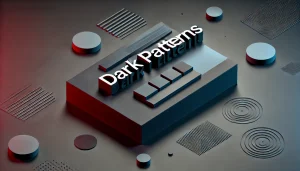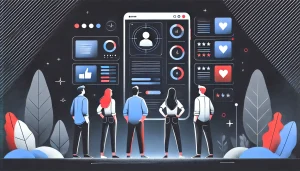
In a world where every click counts and user attention is gold, the fine line between persuasive design and manipulation is often blurred. As businesses compete for conversion rates and engagement metrics, some resort to what are known as dark patterns – deceptive UX strategies that nudge users into actions they may not have consciously intended. On the flip side lies ethical persuasion – thoughtful design that guides users while respecting their autonomy.
So how do we distinguish between the two? Where does persuasion end and coercion begin? This post explores the difference between dark patterns and ethical persuasion in UX, why it matters, and how to stay on the right side of design integrity.
What Are Dark Patterns?

Coined by UX designer Harry Brignull in 2010, dark patterns refer to interface designs that deliberately mislead or manipulate users into taking unintended actions. These actions might include signing up for recurring payments, sharing data they didn’t mean to, or making it harder to opt out than to opt in.
Some common types include:
- Roach Motels: Easy to get into (e.g., free trial sign-ups), hard to get out of (e.g., complex cancellation).
- Bait and Switch: The user sets out to do one thing, but something else happens.
- Forced Continuity: The user’s credit card is charged after a free trial without warning.
- Confirmshaming: Guilt-tripping users into staying subscribed or agreeing to terms.
- Trick Questions: Using confusing language or double negatives to mislead.
What Is Ethical Persuasion?

Ethical persuasion in UX is about influencing user behavior while maintaining transparency, choice, and respect. It taps into cognitive principles – such as reciprocity, social proof, or loss aversion – but uses them to genuinely benefit both user and business.
For example:
- A fitness app nudges users to log their meals regularly using friendly reminders and positive reinforcement.
- An e-commerce site offers limited-time discounts but clearly communicates terms and expiry.
- A newsletter sign-up modal offers value (“Get weekly UX tips”) and makes unsubscribing easy.
Ethical persuasion is not free of influence – no design is – but it’s rooted in informed consent, user autonomy, and long-term trust.
The Psychology Behind Influence

Both dark patterns and ethical persuasion draw on psychological triggers. The difference lies in intent and execution.
Dark patterns often exploit cognitive biases:
- Scarcity (“Only 2 left!” when it’s not true)
- FOMO (Fear of missing out)
- Default bias (Pre-selecting options like insurance add-ons)
Ethical persuasion also leverages psychology but does so transparently. Instead of fake urgency, it might use gentle friction to help users slow down and make informed choices. For example, adding a “Are you sure?” screen before submitting a donation.
The key lies in mutual benefit. If a user understands the offer, freely accepts it, and stands to gain – it’s persuasion. If they’re misled, pressured, or tricked – it’s manipulation.
Why It Matters: Trust, Regulation, and Retention

Trust is the real currency in the digital economy. While dark patterns may boost short-term conversions, they erode long-term loyalty.
Globally, regulators are responding. In 2022, the U.S. Federal Trade Commission (FTC) announced it would take action against companies using deceptive UX to trick users into subscriptions or misuse personal data.
In India, the government has taken decisive steps to rein in such practices. In November 2023, the Department of Consumer Affairs officially classified 13 types of dark patterns as “unfair trade practices” under consumer protection law. These include false urgency, subscription traps, disguised ads, and interface interference – among others.
Most recently, on May 28, 2025, the Consumer Affairs Ministry held a high-level meeting with senior representatives of major e-commerce platforms. They were directed to comply with the dark pattern regulations, conduct internal audits, and publicly display audit results. Consumer Affairs Minister Pralhad Joshi also proposed the formation of a joint working group to address and monitor dark pattern usage more comprehensively.
Even beyond regulation, user expectations are shifting. As people grow more digitally literate, they’re quick to spot and reject manipulation. According to Shopify, over a quarter of users abandon checkouts due to forced account creation, a subtle but impactful dark pattern.
Drawing the Line: Questions Every Designer Should Ask
If you’re a UX designer, product manager, or founder, here are a few questions to help you evaluate whether your design leans toward ethical persuasion or veers into dark territory:
- Is the user fully informed?
Are all terms, conditions, and consequences clearly communicated? - Is it easy to opt out?
Can users reverse or reject the action without friction? - Is the design respectful of user intent?
Are buttons, checkboxes, and flows designed to match what the user logically expects? - Is this nudging or shoving?
Does the design guide or does it corner? - Would we feel comfortable showing this design to users face-to-face?
If not, it might be a dark pattern.
To see how this plays out in practice, consider the example of cookie consent banners:
- Banner A: “We value your privacy. Customize your settings or accept all cookies.” Both choices are clearly labeled, visible, and equally easy to access.
- Banner B: “Accept All” is a large, brightly colored button. The opt-out or customization option is hidden behind several clicks or placed in a hard-to-read link.
Both banners are technically legal. Both aim to secure user consent. But Banner A respects user autonomy by making the choice transparent. Banner B manipulates the outcome by disguising or discouraging alternatives.
Designing for Long-Term Trust

Ethical design doesn’t mean sacrificing conversions. In fact, many companies have found that when they remove dark patterns and build transparent flows, users are more likely to return, engage, and recommend the service.
Take the example of Basecamp, a project management tool that prides itself on honest marketing and clear pricing. Their approach may not be “growth hacked,” but it builds loyal users who appreciate straightforward design.
The Way Forward

Persuasion is part of all design. But in the age of GDPR, CCPA, and growing digital consciousness, businesses must choose whether their influence empowers or exploits.
UX is ultimately about shaping human behaviour. That gives designers and product teams immense power – and responsibility. Drawing the line between dark patterns and ethical persuasion isn’t just about legality; it’s about empathy, integrity, and the kind of internet we want to build.
Conclusion
As designers, we must ask ourselves not just what works, but what’s right. The goal of UX is not to trick users into action, but to support them in making confident, informed decisions. In the battle between dark patterns and ethical persuasion, the future of user experience lies in transparency, trust, and treating users not as metrics – but as people.
Also Read: Navigate CCPA’s Dark Patterns Ban: What You Should Know







